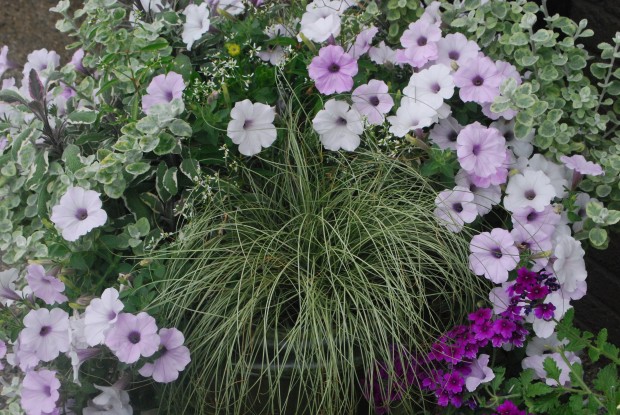The blisteringly hot and persistent heat of the past week has made many a gardener, and the above pictured corgi, miserable. Howard, who would not set foot outside the door if he thought he would get his feet wet, had an alternate plan for yesterday. Strong winds were pushing water over the coping of my fountain. He doesn’t look all that thrilled with his situation, but he had no plans to go elsewhere either. I had to laugh, watching him stand with obvious annoyance in a few inches of water. Just like the rest of us, there was no getting around the heat.
It may be stating the obvious, but plants evolve in response to their environment. Though last week’s Garden Designers Roundtable topic focused on texture in the landscape, there was quite a bit of discussion about how the surface of a leaf says everything about a mechanism for survival. I had never really thought about it before, but plants that live in environments where rain is extremely scarce have evolved to minimize the evaporation of water. Those leaves are thick skinned. Tropical plants where rain is frequent and heavy can survive just fine with thin and jumbo sized leaves.
Petunias are native to Argentina. Many species of helichrysum, like the variegated licorice pictured above, are native to South Africa. The blue-green frosted curls sedge is a cool season grass, meaning it grows best before the advent of hot weather, and after the cessation of hot weather. It tolerates, but does not grow much, in really hot weather. These plants are equipped to handle the heat.
Most of the plants I use in containers are hybrids of non-native, tropical plants. The petunias like to be grown on the dry side, and usually do well in the heat of our summers. They come from places that are routinely hot. New Zealand sedges, of which the hybrid Frosted Curls is an example, are native to a far more temperate zone than mine. They can tolerate our midsummer heat. But not all heat is created equal. Extreme heat is one thing, but extreme heat that goes on for an extremely long time takes a toll.
The petunias are fine, and growing lushly-at the moment. They are dealing with this weather far better than I. The white mandevillea will sit until the weather gets hot-they are native to central and South America. Many mandevilleas are native to Brazil. They grow and bloom like crazy in hot climates. I expect this white mandevillea will get bigger and bloom more should our hot weather persist. Nicotiana species can be found in environements all over the globe. I find mine do quite well over the summer, and rebloom profusely. Nicotiana mutabilis in particular will rev up in the fall, and send out substantial new flowering stalks.
Cassia didymobotrya is commonly known as the popcorn plant. The fragrance of buttered popcorn is strikingly apparent, should you run your fingers across the stems and leaves. It is a shrub, native to South America, that will grow 4 to 6 feet tall in one season. They may grow larger, given a hot season. They make a substantial showing in a container garden. They throw yellow flowers on and off all summer. I am particularly fond of the pea-type leaves. Cassia is a tropical plant with a very airy appearance. Planted in a cast iron cistern placed at the edge of our asphalt street, it looks stress free, and is growing well.
Texas sage is as it suggests-it thrives under desert conditions. I have never had a leucophyllum bloom for me, but perhaps this year I will get lucky. They like desert conditions, but oddly enough require some humidity to bloom well. I cannot believe the usual Michigan humidity is far behind. I know that many grey foliaged plants are native to dry places. Lavenders and grey salvias will not tolerate too much water for long.
I do know there can come a point when heat can severely damage plants. The first line of defense against life threatening damage is to go dormant. Both plants and animals will aestivate, meaning they slow down their activity, in order to conserve moisture and energy. Petunias and impatiens will go out of flower, if they temperatures get too hot, and stay too hot. Our drought-like conditions are not helping one bit with the effects of the heat. Many lawns in my area have gone brown and dormant-they are aestivating. Should the soil temperature gets too high, roots can literally cook. I remember a summer in the mid eighties where many growers in the Cleveland area lost nursery stock from soil temperatures that soared over 100 degrees. There is nothing that can be done to defend against extreme weather like this.
The best I can do to help my plants survive a bout of unusually hot weather is to water them when they need it. Even if that means I am outside with a hose when I would rather be anywhere else. So far, so good.








